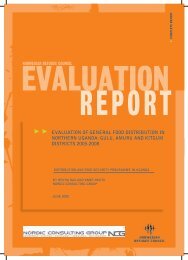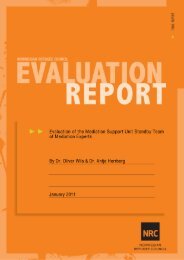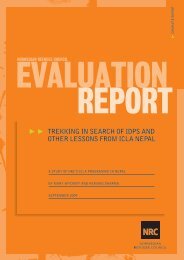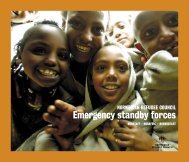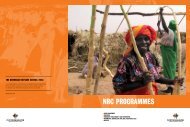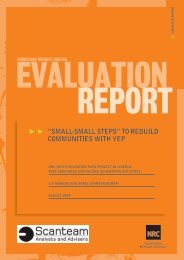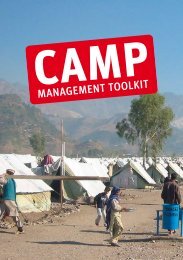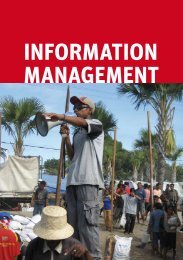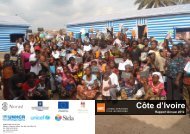Download full report - English version - ProAct Network
Download full report - English version - ProAct Network
Download full report - English version - ProAct Network
Create successful ePaper yourself
Turn your PDF publications into a flip-book with our unique Google optimized e-Paper software.
3.2 SHELTER TYPES AND MATERIALS<br />
The NRC Burundi shelter programme has been running since 1997. It contributes to<br />
the re-integration of returnees, to increasing primary school capacities through the<br />
construction of classrooms, and to ensuring adequate housing and social infrastructure<br />
for refugees and asylum seekers.<br />
It targets Burundian returnees in the provinces of activity, as well as Congolese<br />
refugees, vulnerable groups and asylum seekers.<br />
The main shelter construction projects are:<br />
houses for returnees, made of adobe and iron sheet roofing;<br />
temporary classrooms with a wooden structure;<br />
semi-permanent classrooms with an adobe structure;<br />
permanent classrooms which have a reinforced concrete structure; and<br />
school latrines temporary, semi-permanent and permanent.<br />
Beneficiaries contribute to the various constructions through a number of ways, for<br />
example, by providing mud bricks, by digging pits for house and latrine construction,<br />
by collecting materials and/or by helping dig the foundations for services such as a<br />
school.<br />
Since 1997, approximately 13,000 shelters have been constructed for returnees and the<br />
host population, in addition to more than 800 classrooms. In addition to construction<br />
and repairs, sensitisation sessions facilitated by NRC social workers have been<br />
conducted on various themes including Environment and Education .<br />
Each family receives 50 tree saplings upon completion of their shelters. According to<br />
NRC staff, the survival rate of these saplings is only 25 per cent. It is unclear however,<br />
if the beneficiaries plant all of the 50 saplings or not. Direct observations suggest that<br />
the land to the rear of each shelter is not large enough to accommodate the planting of<br />
50 saplings, in addition to the planting of land for crops. NRC does not give fruit tree<br />
saplings to the beneficiaries it gives Grevillea and nor does it consult with people<br />
regarding the most appropriate tree species to plant. These issues contribute to what<br />
may be regarded as a poor survival rate.<br />
3.3 METHODOLOGY<br />
Two main techniques were used for data collection. These were:<br />
Meetings: These focused on the collection of background and current information<br />
on the Burundian construction industry and materials, as well as local practices<br />
and local environmental issues.<br />
Meetings were held with the following:<br />
o PARESI, Ministère de la Solidarité National de la Reconstruction.<br />
o Boutique Metha, a local supplier.<br />
o The Ministry of the Environment.<br />
28




